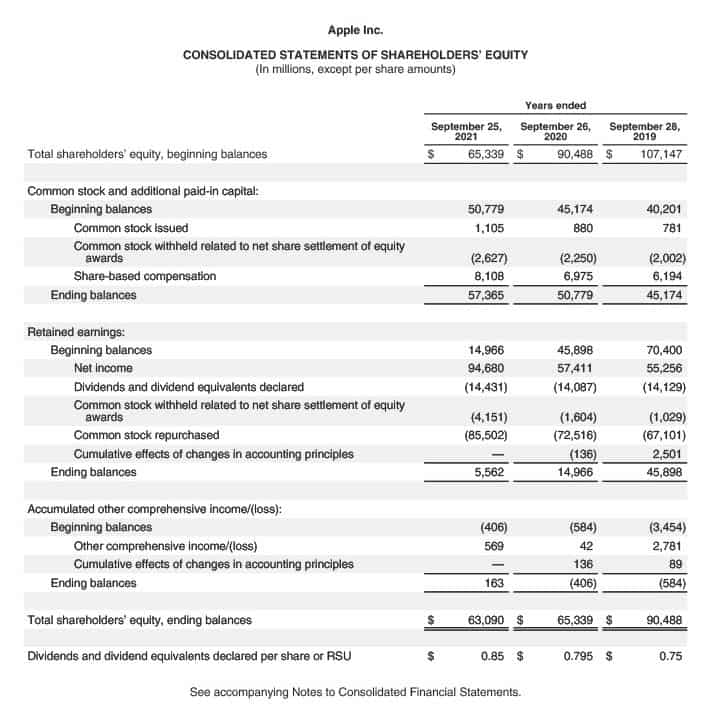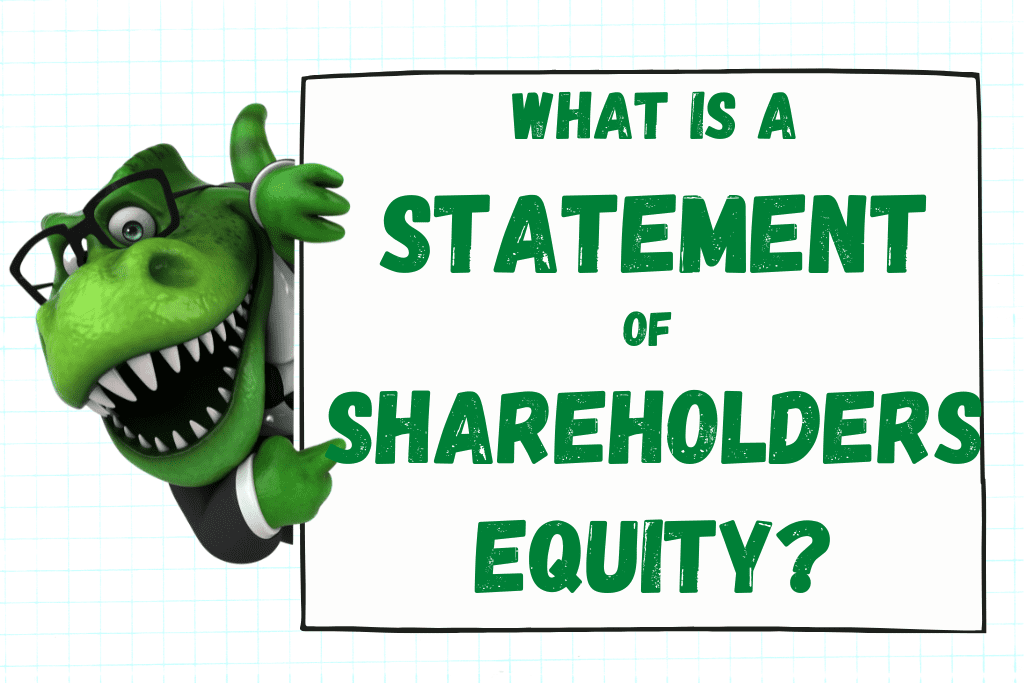The Statement of Shareholders’ Equity is one of the four major financial statements. The function of the Statement of Shareholders’ Equity is to show changes in the value of equity in a corporation. It also serves as the link between the Income Statement and the Balance Sheet where profits and losses are passed from the Income Statement to the Balance Sheet equity accounts.
The Statement of Shareholders’ Equity is also known as the Retained Earnings Statement, Statement of Retained Earnings, Statement of Owner’s Equity, Statement of Partners’ Equity, Statement of Members Equity. The title of the report generally follows the ownership structure of the company.
- Corporations–Statement of Retained Earnings, Statement of Shareholders’ Equity
- Sole Proprietorships–Statement of Owner’s Equity
- Partnerships–Statement of Partners’ Equity
- Limited Liability Companies–Statement of Members’ Equity
In larger corporations, the Statement of Retained Earnings may be a section within the Statement of Shareholders’ Equity.
For more about what Equity is and how it works, check out this article:
How is Shareholders’ Equity Calculated?
The Statement of Shareholders’ Equity reports on the changes that occur to equity during a specified amount of time (month, quarter, year). Shareholders’ Equity is made up of two broad categories:
- Paid-in (or Contributed) Capital
- Retained Earnings
What is Paid-in (Contributed) Capital?
Contributed Capital is also called Paid-in Capital. It includes any amounts “contributed” or “paid in” by investors or stockholders through purchasing of stocks or other investments. Contributed Capital includes:
- Outstanding Shares — Contributed Capital is increased by amounts paid into the corporation by purchases of the corporation’s stock by investors.
- Additional Paid-in Capital — Contributed Capital is increased by amounts paid into the corporation by purchases of the corporation’s stock above the par value by investors.
- Treasury Stock — Contributed Capital is decreased by the amounts spent by a corporation to buy back its own stock.
For more information about Paid-in Capital, check out this article:
What is Retained Earnings?
Retained Earnings is the cumulative amount of profits and losses for a business less any dividends paid to owners (sole proprietors, partners, members or shareholders).
What is Net Income?
Net Income is the difference between Revenues and Expenses. When Revenues are greater than Expenses, a company has Net Income (Profit). When Expenses are greater than Revenues, a company has a Net Loss (Loss). Net Income increases the value of an owner’s equity in a business. Net Loss decreases the value of an owner’s equity in a business.
For more information about Net Income, check out this article:
What are Dividends?
A dividend is a business distributing some or all of its earnings (profits minus losses) to its owners. For a sole proprietorship, this may be called a Dividend, Distribution, Owner’s Draw, or Owner’s Withdrawal. For corporations, it is generally referred to as a Dividend.
A dividend reduces the amount in Retained Earnings since it is the distribution of earnings. The corporation is taking money out of the business to give to owners (shareholders).
For additional information about accounting for Dividends, check out this article:
Statement of Shareholders’ Equity Example
Paid-in Capital + Retained Earnings – Treasury Stock = Total Shareholders’ Equity
The basic format for the Statement of Shareholders’ Equity divides transactions into categories for Paid-in Capital (stock transactions), Retained Earnings (profits and losses minus dividends), and Treasury Stock (a corporations own stock it has purchased back from the market.)
Statement of Shareholders’ Equity
| + Paid-in Capital |
| + Retained Earnings |
| – Treasury Stock |
| Total Shareholders’ Equity |
Each section then lists details of the what that category is made up of.
Paid-in Capital
- Preferred Stock, number of shares at par and related percent
- Common Stock, number of shares at par
- Additional Paid-in Capital, amount paid above the par value of the stock
Retained Earnings
- Beginning Retained Earnings
- Net Income or Loss
- Dividends paid on Preferred Stock
- Dividends paid on Common Stock
Treasury Stock
- Treasury Stock, number of shares at cost
For more information about Stocks and Stock transactions, check out this article:
How to Prepare a Statement of Shareholders’ Equity
- Determine time period to be covered. The statement is generally prepared monthly, quarterly, or yearly.
- Begin with the ending balances from the previous period.
- For Paid-in Capital section, record the share totals at par and the amount of additional paid-in capital above par value.
- In the Retained Earnings section, add Net Income (or subtract Net Loss) for the total period covered by the statement being prepared. This number comes from the Income Statement (Profit & Loss Statement) for the company.
- Subtract Dividends paid to the owners or shareholders during the period of time the statement covers. This number comes from the activity in the Dividends account in the Chart of Accounts.
- The remaining balance is the ending balance in the Retained Earnings section.
- As with all financial statements, the heading of the report shows the name of the company, the name of the report, and the period of time the report is based on (month, quarter, year).
Statement of Shareholders’ Equity for Apple Inc.
In the example Statement of Shareholders’ Equity report below, focus first on the Retained Earnings section. It starts with the beginning balance, adds net income, and subtracts dividends. The other items included in Retained Earnings are specific to the company. One item to note is the “Common stock repurchased” line. The company has used a large portion of its earnings to buy back its own stock (Treasury Stock.) In the Paid-in Capital section, the corporation lists the common stock portion of equity.

For more information about accounting for Treasury Stock, check out this article:
What Does the Statement of Shareholders’ Equity Show?
The job of the Statement of Shareholders’ Equity is to tracks changes in the equity for all owners. It indicates how a corporation is choosing to use its earnings.
Is it distributing the excess earnings to shareholders as dividends or is it holding on to earnings to finance large projects or initiatives? Is it using the the earnings to buy back its own stock in the form of Treasury Stock?
Like all financial statements, the Statement of Shareholders’ Equity gives one view of the finances of a business. When the Income Statement, Statement of Shareholders’ Equity, Balance Sheet, and Statement of Cash Flow are examined separately and as a whole, a picture of the overall health and decisions of the company can come into focus.
For more information and examples about the Statement of Retained Earnings/Owner’s Equity/Shareholders Equity report, watch this video:
For access to the example spreadsheet in the video, click this Google Drive link: Statement of Owner’s Equity Examples
-
How to Know What to Debit and What to Credit in Accounting
If you’re not used to speaking the language of accounting, understanding debits and credits can seem confusing at first. In this article, we will walk through step-by-step all the building
-
How to Analyze Accounting Transactions, Part One
The first four chapters of Financial Accounting or Principles of Accounting I contain the foundation for all accounting chapters and classes to come. It’s critical for accounting students to get
-
What is an Asset?
An Asset is a resource owned by a business. A resource may be a physical item such as cash, inventory, or a vehicle. Or a resource may be an intangible
-
What is a Liability?
A Liability is a financial obligation by a person or business to pay for goods or services at a later date than the date of purchase. An example of a
-
What is Revenue?
Revenue is the income generated by a business in the normal course of operations. It represents the sale of goods and services to customers or clients. For a non-profit organization,
-
What Does Prepaid Mean in Accounting?
In accounting, a Prepaid account represents cash expended prior to goods or services being received. Examples of Prepaid accounts are Prepaid Expense, Prepaid Rent, and Prepaid Insurance. A Prepaid account

